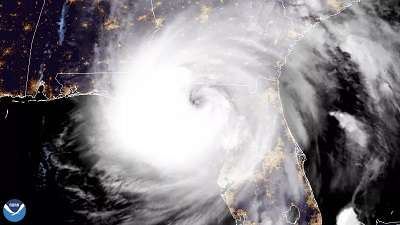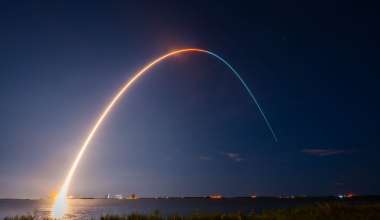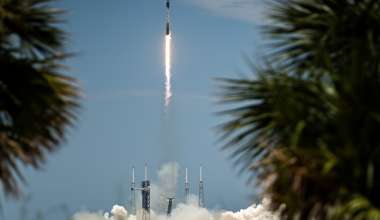As Hurricane Helene made landfall near Perry, Florida on Sept. 27, the National Oceanic and Atmospheric Administration (NOAA) captured the phenomena through the Geostationary Operational Environmental Satellites (GOES) system and issued advanced warning of the impending Category 4 storm as it was forming. Just two weeks later and about 200 miles further south, Hurricane Milton made landfall as a Category 3 storm—only days after becoming the fastest storm to intensify into a Category 5 in the Gulf of Mexico.

Space-based capabilities have long played a critical role in weather and environmental monitoring on Earth, enabling innovative advancements for weather forecasting, natural disaster preparation and rescue coordination. The importance of the reliable—and potentially lifesaving—imaging and data these capabilities provide has only grown as damaging natural disasters including hurricanes and wildfires have become pronounced in recent years.
As a collaborative effort between NOAA and NASA, the GOES program maintains a two-satellite operational system for continual view of the Western Hemisphere from approximately 22,300 miles above Earth – one satellite in the GOES East position and the other in the GOES West position. Together, GOES-East and GOES-West watch over more than half the globe, from the west coast of Africa to New Zealand and from near the Arctic Circle to the Antarctic Circle.
The GOES constellation protects the 1 billion people who live and work in the Americas. The current generation, known as the GOES-R series, are the U.S.’s most advanced fleet of geostationary weather satellites.
Throughout the mission lifecycle, The Aerospace Corporation supported the GOES-R program across a breadth of activities and milestones, contributing its unparalleled depth of technical expertise and fostering an integrated perspective to solve the hardest problems.
“Aerospace has supported the GOES-R series since its inception,” said Peter Phillips, Principal Director in the Civil Systems Group at Aerospace. “Our primary focus is providing embedded systems engineering support, where we are working shoulder-to-shoulder with NOAA and NASA across the mission lifecycle.”
Understanding the Value of Space
Since the very first GOES satellite launched in 1975, the program has continually evolved new technological advancements and innovations to become increasingly essential to U.S. weather monitoring and forecasting. Today, NOAA provides terrestrial data and space weather data gathered by GOES to researchers and service providers across the globe, including the National Weather System. Meanwhile, NASA is responsible for the procurement, design, and development of the GOES satellites.
“When you think about a time before we had weather satellites, one of the best examples being the Galveston Hurricane disaster that happened in 1900. Nobody saw it coming, and thousands of people died,” Phillips said. “The motivation for weather prediction eventually led to weather satellites, and that directly contributes to preserving life, health and property. The GOES satellites in particular really are hurricane hunters and hurricane finders, and just the fact that they're able to give advanced warning many days ahead for people to clear out has literally helped to save millions. You can't put a value on that.”
The imagery of Hurricanes Helene and Milton was captured by the GOES-16 satellite, which is currently operating as GOES East. GOES-16 was the first among the four GOES-R satellites of the current generation to launch back in 2016. Its successor, GOES-19, launched in June 2024 and will replace GOES-16 as GOES East next spring once it becomes fully operational.
While GOES-19 is currently undergoing post-launch testing, NOAA did recently release the first imagery of Earth from the new satellite. According to NOAA, the stunning views were captured by GOES-19’s primary instrument, the Advanced Baseline Imager (ABI), and demonstrated 16 different channels – each measuring energy at different wavelengths along the electromagnetic spectrum to obtain information about Earth’s atmosphere, land and ocean.
Forging the Path Forward
The GOES program isn’t just about the satellites in orbit, either. In fact, GOES-R includes a very robust ground system to process the significant volume of data in order to be delivered to users. During the development and integration phases of the GOES-R program, Aerospace’s embedded team was instrumental in working with various key stakeholders to ensure the successful implementation and transition of operations ahead of the first launch. In addition to supporting the flight operations, Aerospace also led a first-of-its-kind data operations support team, actively managing processing and delivery of all GOES data products to users.
“NOAA makes the data widely available for users,” Phillips said. “That critical weather data is shared all over the world. I've heard it described as one of the best diplomatic tools of the United States, because for the past 50 years, we’ve provided free weather data to everyone.”
Aerospace also collaborated with operations and engineering stakeholders to ensure space-to-ground communications worked flawlessly throughout the GOES-R missions. In addition, Aerospace’s experts provided valuable technical contributions to address hardware challenges, including resolving issues with the uplink/downlink antennas.
For his leadership and impact, Phillips was recognized by NASA with the 2012 NASA Distinguished Public Service Medal—the highest award NASA can give to a non-civil servant, the 2015 Robert Goddard Exceptional Achievement for Customer Service Award, and the 2014 GOES-R Program Esprit de Corps Award. In 2016, he was also the recipient of Aerospace’s President’s Achievement Award for his contributions.
Aerospace’s Renee Dudley, Systems Director supporting the GOES/GeoXO Program Office, was also recently recognized as NOAA’s Team Member of the Month for her accomplishments in overseeing the Naval Research Laboratory’s (NRL) development of the new Compact Coronagraph (CCOR) for GOES-19. CCOR is the first-ever coronagraph on a NOAA operational satellite and will enable operators to monitor dangerous space weather conditions, specifically coronal mass ejection that could negatively impact space assets and astronauts.
“The CCOR design is much smaller and lighter than previous generations of coronagraphs, allowing it to be deployed on smaller, more cost-effective missions,” Dudley said. “I am proud to have been a part of a fantastic team of NRL, NASA and NOAA engineers and scientists, all of whom worked together to ensure the success of a mission whose primary purpose is to protect life and property.”
Building for the Future
With the final GOES-R satellite now in orbit, NOAA is already looking to develop and build the next generation weather satellite constellation. The Geostationary Extended Observations (GeoXO), which will expand on GOES-R, will advance capabilities to address emerging environmental issues regarding the weather, ocean and climate. Aerospace is already supporting the early stages of this program, which plans to begin operating in the early 2030s.
“Among the various efforts we’re involved in, Aerospace is currently conducting an economic impact study for the new generation in GeoXO,” said Phillips. “In terms of economic impact and the value of weather forecasting and prediction, it’s in the billions of dollars a year. Of course, in terms of the impact Earth observation and weather satellites have on families’ ability to plan and respond to weather events, its value is incalculable.”





